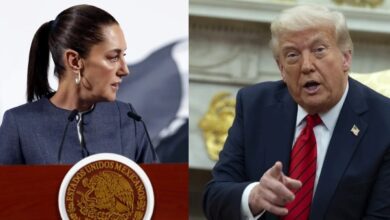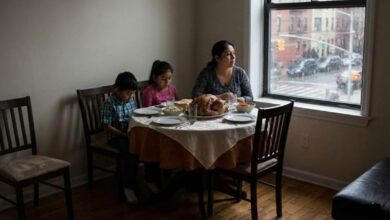Coronavirus: State of disaster in the United States
For the first time in history, the United States decreed a state of disaster throughout its territory due to the scope of the global health emergency

Donald J. Trump addresses his comments during the coronavirus briefing in the White House Press Room. / Photo: D. Myles Cullen – Official White House
LatinamericanPost| Juliana Suárez
Listen to this article
Leer en español: Coronavirus: Estado de desastre en Estados Unidos
COVID-19 went from having its epicenter in China to Europe and today it is in the United States, a country whose contagion cases are practically a third of the world contagions and which has the highest number of deaths.
With 560,000 infections and rising to approximately 30,000 per day, the situation got out of hand for the US government, which has changed its position over the days. President Donald Trump has been, in the opinion of many of the country's governors, soft on decisions and while most countries remain in a mandatory quarantine, in the United States the states have had to respond independently of the federal government and even today with those numbers, you see people in the cities.
This increased risk was the key for Donald Trump to enact a state of disaster (Presidential Disaster Declaration) for the first time in the country's history. This decision was made to make it easier for the federal government to serve the needs of each state's governors and protect the health of Americans.
For the first time in history there is a fully signed Presidential Disaster Declaration for all 50 States. We are winning, and will win, the war on the Invisible Enemy!
— Donald J. Trump (@realDonaldTrump) April 12, 2020
This statement refers to the fact that the situation (in this case health) exceeds the powers of governors or mayors and they need federal support. Days before announcing it, the governors had begun sending their statements to the White House, calling for the Presidential Disaster Declaration to be enacted. In this case, states may request financial support, sanitary supplies, and other needs that may arise to combat the health emergency and ensure the health and well-being of citizens.
Likewise, the federal authorities warned that April will be a month of much observation to determine if in May the restrictions begin to be lifted. This decision will be made depending on the needs of each state, foreseeing that in some the emergency will continue actively and it cannot be lifted.
Among the statements of Dr. Anthony Fauci, health adviser to the federal government during the health emergency, there was also talk about the presidential elections, and although no decision has been made about how to postpone them, there is still the possibility that at that time the emergency continues. However, he said: "I think we have a good path, a moderate path to move towards normality and we hope that by the time we get to November we can do it in the conventional way."
For now, both federal and state authorities are focusing their attention on preventing the spread with distancing measures and other restrictions and seeking to provide health care and treatment to those who need them.
Also read: How's the race to find the Coronavirus vaccine?
In his remarks, Fauci admitted that if the measures had been taken early, more lives could have been saved. However, with current projections, deaths in the United States are expected to reach 60,000 by August.
Just before declaring a state of disaster, the New York Times had published an article that compared the position of Trump and his allies against that of the governors of many states. The president's position has been criticized for not taking more drastic measures across the country in a timely manner, while he has defended production so as not to irreversibly affect the economy. At the time, he assured that confinement measures could be more harmful than the disease itself: "We cannot have a worse cure than the disease," he said weeks ago, referring to measures that would slow down the economy (we can't have the cure be worse than the problem).
On the contrary, the governors have stated that, although a balance should be found with the economy, preventive measures for health come first. This, because they were criticizing that the federal authorities would begin to lift some restrictions throughout this month since many, such as the Governor of New Jersey, one of the most affected states, are against the "reopening" of the country in the upcoming weeks
The pandemic and the world
While on this side of the world the situation worsens with the increase in cases in Latin America and the epicenter in the United States, the situation in the East is prosperous. Days ago, on April 8, Wuhan, the city where the patient zero of the epidemic was known, ended a mandatory confinement that took more than two months. To celebrate the return to the city, the streets were filled with a light show. Protection measures and sanitary controls will continue to be used in some places such as public transport, but the 11 million inhabitants will already resume their routines.
For its part, Europe is in a key week because it is no longer the epicenter and for a few days the numbers no longer continue to increase in the magnitude that they were doing a month ago. Still, five European countries have lower infections than the US (Spain, Italy, France, Germany and the United Kingdom).
The flattening of the curve opens up the possibility that the situation in Europe will begin to improve little by little, which is why some countries have begun to reduce their restrictions and to reactivate their economies. Some sectors such as manufacturing and construction, as well as businesses such as stationeries, bookstores, and some stores will open in countries such as Spain and Italy.
Other countries will begin reopening schools and kindergartens, and others plan to open the hotel and restaurant industry next month. These measures will be regulated over the days if it is possible to keep the situation under control so that it does not start to increase again.





